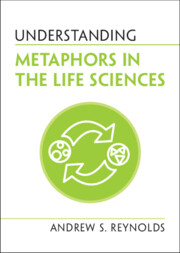Book contents
- Understanding Metaphors in the Life Sciences
- Series page
- Understanding Metaphors in the Life Sciences
- Copyright page
- Additional material
- Dedication
- Contents
- Foreword
- Preface
- Acknowledgements
- 1 Metaphors and Science
- 2 Background Metaphors
- 3 Genes and Genomes
- 4 Proteins
- 5 Cells
- 6 Evolution
- 7 Ecology
- 8 Biomedicine
- Concluding Remarks
- Summary of Common Misunderstandings
- References
- Index
2 - Background Metaphors
Agents, Machines, and Information
Published online by Cambridge University Press: 11 April 2022
- Understanding Metaphors in the Life Sciences
- Series page
- Understanding Metaphors in the Life Sciences
- Copyright page
- Additional material
- Dedication
- Contents
- Foreword
- Preface
- Acknowledgements
- 1 Metaphors and Science
- 2 Background Metaphors
- 3 Genes and Genomes
- 4 Proteins
- 5 Cells
- 6 Evolution
- 7 Ecology
- 8 Biomedicine
- Concluding Remarks
- Summary of Common Misunderstandings
- References
- Index
Summary
Given the wide range of possibilities to draw from, one might expect the metaphors being used in the life sciences to come from a wide variety of source domains. After all, if you’re trying to describe an organism and understand how it works, for instance, you could in theory compare it to anything. But as a matter of fact, the metaphors one tends to find in the life sciences fall into three broad categories: agents, machines, and information. I will refer to these broad categories as background metaphors. All three involve teleological thinking – that is, the assumption that things are (or that it is at least a helpful heuristic to suppose they are) either designed to fulfill certain functions or have plans of their own they are attempting to achieve. We will also look at a smaller number of metaphors drawing on natural objects as the source domain, but the majority to be covered in this book will fall into the three chief background metaphor categories of agents, machines, and information.
- Type
- Chapter
- Information
- Understanding Metaphors in the Life Sciences , pp. 14 - 26Publisher: Cambridge University PressPrint publication year: 2022

